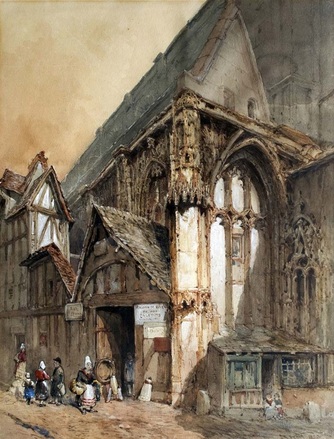Rue St Etienne, Rouen
|
Research by Susan Auty
|

Acc No 45
Artist John Skinner Prout
Artist dates 1804-1876
Medium watercolour and gouache
Size 50.80 x 38.10 cm (20 x 15 in)
Date painted 1855
Inscr signed and dated J S Prout 1855
Donor Mrs A M Catterall, Little Nutcombe, Hindhead, Surrey
Date donated 24 December 1945
Artist John Skinner Prout
Artist dates 1804-1876
Medium watercolour and gouache
Size 50.80 x 38.10 cm (20 x 15 in)
Date painted 1855
Inscr signed and dated J S Prout 1855
Donor Mrs A M Catterall, Little Nutcombe, Hindhead, Surrey
Date donated 24 December 1945
|
ARTIST
John Skinner Prout (1804-1876) was born in Plymouth, the nephew of an artist of medieval architecture from whom it is likely he acquired his artistic skills and knowledge of lithography. His own artistic career began with sketches of ancient monuments that were eventually published as a monograph, The Castles and Abbeys of Monmouthshire, in 1838. (1) Despite being elected to the Society of Painters in Water Colour he did not prosper and decided to emigrate in 1840, with his wife and seven children, to Sydney, Australia, where his brother had settled. There, he ran a lithographic plant as well as lecturing at the School of Arts, later presenting a lecture series throughout the country. He travelled extensively, including Tasmania and Norfolk Island, doing sketches and paintings of rural life; these were eventually published. He was known especially for his rural subjects and landscapes painted en plein air, interpreted freely rather than scrupulously copied. However, life was still difficult, especially after his ten year old son was killed by a random stone in 1845. Leaving behind a married daughter, the family returned to England in 1848. Continuing to lecture and exhibit, especially on emigrant and Aboriginal life in Australia, Prout also published more volumes; these ran to several editions implying some success in his field. He continued to travel and to paint and at some point probably returned to Australia for a visit. PAINTING His trips to the continent yielded many sketches and watercolours that are still being auctioned today. His watercolour and gouache of Rue St-Etienne, Rouen, on display here, is very like his Continental Street Scene, which hangs in the Reading Museum and was probably painted at the same time. (2) Both paintings combine intricate architectural details with sketchy figures, although the Rue St-Etienne shows a church rather than an ordinary half timbered dwelling. The contrast between the elaborate gothic tracery of the church and the crude adaptations tacked onto the building must have appealed to his eye for lively scenes. A French postcard of Rue St-Etienne des Tonneliers (Coopers), photographed circa the end of the 19th century, gives a clear view of the same church. (3) The little hut attached to the front of the building is still evident but is boarded up and the canopy over the door in Prout’s painting, which appears to provide market space (100,000 overcoats are advertised on the door and items are propped up as if for sale), has disappeared behind hoardings. At the time of the photograph the church no longer seems to be used for any purpose and it was destroyed, as was the rest of the street, in WWII. The women in the photograph still wear long white aprons but there is no sign of the distinctive headgear shown in Prout’s picturesque scene. Perhaps he intended to evoke traditional French provincial life with the unusual bonnets. This detail could be an instance of Prout exercising his artistic rights to interpret what he saw. |
REFERENCES
(1) Entry in Australian Dictionary of Biography by V W Hodgman http://adb.anu.edu.au/biography/prout-john-skinner-2565 (2) http://www.artfund.org/what-we-do/art-weve-helped-buy/artwork/6905/continental-street-scene-john-skinner-prout (3) Image of Rue St-Etienne des Tonneliers http://www.cparama.com/forum/la-vieilles-rues-t8716.html |
